Public Art and Planning
The following paper was specifically commissioned by PASW in 2008.
- Planning shapes the places where we live and work. Good planning promotes development that meets the needs of the present without compromising the ability of future generations to meet their own needs.
- Public art is a process of engaging artists’ creative ideas in the public realm.
- A significant amount of public art in England is commissioned via the planning system.
Introduction
At a time when standardised approaches to design and development have been widespread, it is acknowledged that public art has a significant role when creating successful places and helping to establish successful and vibrant communities. The planning system is central to the control of development, and is increasingly concerned with the quality and longer-term sustainability of new development. Design has become a material consideration, not only in visually sensitive areas, and planning authorities are encouraged within national planning policy statements to reject ‘design which fails to take the opportunities available for improving the character and quality of an area’.
Follow this link to the Public Art Online National Planning Policies section.
Designing for place is a key objective of advisory bodies such as the Commission for Architecture and the Built Environment (CABE), and artists have a role to play in responding to a specific site and adding identity, distinctiveness, interpretation and relevance.
Public art encourages partnership between artists, craftspeople, design professionals, developers and local communities. It can help stimulate the local economy, creating employment opportunities for artists, craftspeople, manufacturers and suppliers. In some cases public art can attract additional funding to a scheme, from grant giving bodies and sponsorship.
This guide promotes a range of planning led approaches for securing the integration of public art, both within key development schemes and through the delivery of public realm improvements. In addition, it considers the mechanisms and benefits of developing strong public art strategies for incorporation into local authority policy frameworks.
Written from the planning perspective these guidelines are in the first instance aimed at planning officers and policy makers wishing to develop best practice public art as part of a broader design agenda. In addition, it is hoped that the issues covered will offer artists, developers and agents an insight into the provision of public art though the planning system.
"Public art is not an art form. It is a principle whereby the involvement and activities of artists contribute to the identity, understanding, appreciation, and enhancement of public places.
This is best achieved through collaboration with artists in the conception, design development and implementation of changes to the built and managed environment."
Maggie Bolt, PASW
In 2009 IXIA the public art think tank requested legal opinion regarding public art and the planning system, the findings of which very much echo the recommendations set out within this paper.
The opinion reinforces the assertion that public art is a material consideration within the planning system, however in order require public art though the development process that clear local planning policies need to be established within Local development frameworks. Furthermore the opinion raises some concerns regarding the generic approach of blanket percent for art and tariffs, as it is harder to demonstrate the specific, and reasonable relationship to specific sites and types of development.
As such the approaches outlined below of identifying and prioritising major development sites where the role and benefits of integrating a public art approach can be set out, and where public art in the public realm is considered and costed as a basis for seeking off-site contributions, provide the most effective ways of securing public art through the planning system.
Public Art Strategies
The most successful strategies allow for being opportunistic, as well as planning ahead to deliver well considered priorities. They will include a focus on key development sites as part of more strategic guidance related to the delivery of both stand alone public art initiatives and integrated work within public infrastructure such as schools, hospitals and transportation systems.
Local authorities should be clear regarding aspirations and locations where high quality design is required and how public art is expected to contribute to the built environment. Local planning policies should provide certainty with regard to what is expected from developers, and planning guidance should establish criteria against which major new developments are judged or appraised with regard to the integration of public art.
At the strategic level it is important for authorities to set out their specific approach to public art, highlighting how they will integrate work within their own capital projects as well as their expectations for others through the planning system. The importance of leading by example should not be underestimated in creating a positive context where local communities value the benefits of public art.
Principles and objectives for public art should be given local emphasis and made relevant to local circumstances and expectations. Local traditions and recent work should be highlighted in order to legitimise the way in which existing public art contributes to the distinctiveness and identity of local areas.
A strategy should establish consistent guidelines for selecting, recruiting and briefing artists, and ensure the effective and appropriate project management support, maintenance and where appropriate decommissioning.
Follow this link for examples of public art strategies that have been adopted by local authorities.

Banksy, Park Street, Bristol. Photo: Mark Luck
Street art or vandalism? Public art strategies can raise public debate about the benefits of art in the built environment.
Local Development Frameworks
In planning terms policies carry more weight if the authority formally adopts them. Local planning policies are set out within a portfolio of documents, which together form the Local Development Framework (LDF); this replaces the all-encompassing and slow to produce Local Plans. The system is intended to produce better policies for development that are more proactive and responsive to local needs and circumstances. Responsibility for producing LDFs is given to Unitary Authorities, Borough and District Councils.
The LDF contains a number of types of documents which set out development policies and proposals, and which provide both detailed and supplementary guidance. These documents are required to be consistent and complementary to national and regional planning policies, and in particular the location and quantity of new development established through the Regional Spatial Strategy (RSS). There are, however, opportunities to develop a finer level of detail that responds directly to local issues and cover more specific aspects of the design agenda.
A range of public art issues can be covered within LDFs, from principles to support creative design approaches to more detailed site briefs and guidance. Each individual document is approved by the Secretary of State following a prescribed process of community consultation. The main documents include:
- The Core Strategy is the key document, which sets out the broad objectives for the area. Typically a Core Strategy will define the main areas of development priority, an analysis of the areas main characteristics and strategic policies covering infrastructure requirements, the use of land and standards of design quality. With regard to public art it is useful for Core Strategies to include a commitment to achieving public art to support both aesthetic and cultural standards within the local area.
- Area Action Plans (AAP) provide a detailed framework for areas where significant change or conservation is needed and focus on the delivery of development objectives. The main purpose is to ensure that development is of an appropriate scale, mix and quality. Here specific sites for landmark buildings or public realm improvements can be highlighted in greater detail along with aspirations for the integration of public art.
- Generic Development Control Policies are set out to provide an additional and limited set of policies to guide decisions on planning applications. These can include detailed requirements for public art provision, such as the scale of development where planning obligations requiring public art will be expected.
Supplementary Planning Documents (SPD) do not carry the legal weight of Development Plan Documents but are produced to elaborate on specific policies and proposals, and are taken into account when assessing planning applications. SPD are not subject to Secretary of State approval but are subject to community consultation. Examples of SPD would include individual site briefs or topic-based guidance on issues such as affordable housing, or public art.
Another form of SPD might be the increasingly common drawing up of design codes for an area or larger development scheme. There is some debate as to the drawing up of codes and whether they sit comfortably with the concept of artists delivering interpretive work, within what are sometimes regarded as strict design rules and constraints. In such circumstances it is useful to look at the experience and conclusions from the US where design codes are more established as a planning tool. Responding to the success of codes in Gaithersburg, Maryland, commentator Mike Watkins concludes:
“Code only what matters then hire good architects. Surprisingly little is essential to code most great places. As the list of rules grows in an effort to outlaw kitsch, the opportunity to produce truly excellent building may diminish. Enforce the code with an eye towards exceptions. The importance of enforcing the code is obvious. While enforcing the code, permit exceptions which make the place, well, exceptional.”
Although focusing on building design, the same can be said of the streets and public spaces, and the role of public art can be seen to contribute to making places distinctive and identifiable. Whilst this may appear harder to code for, it is reasonable to identify locations, uses and activities where a more bespoke design approach is required.
Follow this link for examples of relevant local development framework documents that have been adopted by local authorities.
Priority Development Sites
The current practice of negotiating public art from planning applications is of value, but the present system largely relies on individual planning officers and can be difficult to administer. It should be understood that not all applications offer the same opportunities, and that the result of a development led approach to public art can result in a cluttered and uncoordinated delivery of smaller public art works. In itself this approach can bring about criticism of public art, particularly where the resultant works are seen to be of less value in enhancing the public realm, and where the purpose of including public art within development schemes may be seen by some as a tick box exercise.
One approach to delivering public art through the planning system may be to limit the number of sites where public art is negotiated and delivered as an integral part of development proposals. By focusing on a small number of key sites where the location, prominence and use make the inclusion of public art most appropriate and deliverable, efforts can be focused on establishing key criteria, expectations and delivery mechanisms. Outline briefs for each of the key sites identified should be drawn up to establish a stronger rational for the inclusion of public art as a priority, when balanced against other development contributions. This will particularly help development control officers in brokering public art as an integral part of the development at the pre-application stage.
Key sites should be limited in number. Factors that will lead to a site being looked at in this way might include the need to establish a landmark design at a key gateway or junction, to interpret an aspect of the sites history, to improve legibility within the townscape or to act as a focus or activity for a new community.
‘Percent for Art’
‘Percent for Art’ can be a useful way to gauge the contribution that might be expected from a specific new development. However, the phrase should generally be loosely applied in the context of the British planning system.
The term originated in the United States where concerns over the aesthetic qualities of development resulted in the concept of using one percent of the capital costs of any development to enhance the development by incorporating works of art or craft. The scheme, linked to city ordinances or local enforceable laws, was pioneered in Philadelphia in 1958 and was soon adopted by many of the larger cities including New York, Chicago and San Francisco.
In 1989 the Arts Council promoted the use of ‘Percent for Art’ in Britain. It recommended that this should be done through the planning system, and by the incorporation of policies within local plans. The capital costs of any development are not, however, a determining factor within British planning legislation, and as such the local authorities may not know the precise cost of development. ‘Percent for art’ cannot therefore be taken literally and is encouraged on a voluntary basis rather than imposed. Many authorities have adopted such voluntary policies, however the cost of public art can be a grey area for many planners.
Persuading Developers to Work with Artists
In order to encourage the incorporation of public art, it is important to understand what arguments will best persuade developers to work with artists. Taking a hard line on pushing cost driven ‘Percent for Art’ may feel like a tax on development and does not always work. It may be better to focus on aspects such as the benefits to improving the visual quality of the development, adding identity and long term value to a property, or as a way of effectively engaging with local people during a period of change.
It is particularly useful in areas where there are expectations for high quality design, such as town centres, conservation areas or prominent sites, to explain the contribution that artists bring as part of the overall quality of design from concept through to detail, and how this will be considered as a positive aspect of achieving the required design quality.
Pre-application discussions can be aided by the use of locally produced public art strategies, which formally set out policies and rationale that cover the inclusion of public art. Demonstrating the contribution of existing and planned work, through illustrations and maintaining a record of good local practice, provides a strong argument that a creative approach to design in the public realm is an essential characteristic of the local area.
The integration of work as opposed to freestanding work can also help to persuade developers who have particular concerns about the financial viability of projects. Many of the essential elements that make up a building or landscape are often suitable for artistic interpretation, and can be provided at a relatively small proportion of the overall budget, over and above that of a standard item. For example, entrances, surrounds, cladding, doors, windows, balconies, lighting, signage, gates railings, seating and paving areas can be individually commissioned to give a development special identity.
Being flexible is a key aspect of encouraging artworks. Each development will have different circumstances with regard to the site, funding, the experience of the project team, and the nature of the scheme. Ideally artists should be included at the earliest possible stage of scheme design, however, the developer may be unwilling to fund a multi-disciplinary design team until the principle of development or scheme viability has been fully determined. Many designs evolve after the formal planning process, and with appropriate agreements or conditions in place further design development to incorporate public art can be achieved. In such cases it is essential that a strategy for developing the public art elements has been agreed before permission is granted. Where an artist is not involved in developing the strategy it is important to allow for a reassessment of the public art potential following the appointment of the artist.
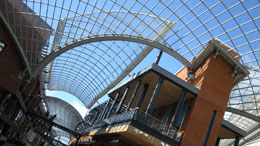
Nayan Kulkami, Central Roof, Cabot Circus, Bristol.
Photo: Mark Luck
Integrating artworks within the fabric of the building makes best use of resources, and can help to foster collaboration between the artist and the project team.
Engaging with the Artist
In order to encourage successful collaborative working which, will foster the integration of artists' work into future developments, it is essential that clients, developers and their project teams have a key role in the selection and development of the public art proposal. On larger schemes, or where developers have no previous experience of working with artists, it may be necessary to provide proactive support or bring in professional advice, provided by a dedicated public art project manager, to help identify opportunities, draw up a brief and establish a method for selecting artists.
It is also recommended that a clear process of engagement with local stakeholders is put in place in order to encourage dialogue, and foster ownership, understanding and civic pride.
Follow this link to the Public Art Online Project Management Practical Advice Sheet.
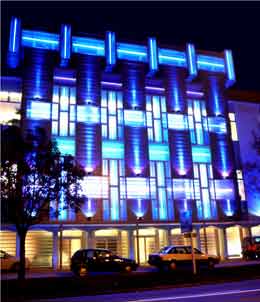
Peter Freeman, Lighthouse, Poole Centre for the Arts.
Photo: Peter Freeman
Developers often see artistic lighting as a good way of integrating work, but such treatments should really be reserved for important civic buildings or those that contribute to the night time economy.
Follow this link to the Public Art Online Artists and Light Information Sheet.
Mechanisms for Securing Art
The preferred method for securing public art though the planning system would be to have the artist work with the design team at the concept stage through to planning design, and for the fully developed public art proposal to be an integral part of the scheme that is given permission. Physically integrated works would mean that the scheme could not be completed without the artwork, unless a formal design amendment, usually now in the form of a new application, were to be submitted and approved.
It is common, however, that public art proposals are not fully developed at this stage, and as such there is a need to put in place some form of agreement with the planning permission to ensure that the proposal is worked up and implemented alongside the development.
Planning permission is usually granted subject to a number of conditions and these can cover issues such as detailed design development and public art. Conditions can be appealed by the applicant, and in some circumstances removed, however as part of a major development such design issues are not normally regarded as problematic by the developer. Working with the developer to highlight the importance of the aesthetic and public art aspects of a scheme should also mean that such conditions will be expected.
Public art conditions should relate back to an agreed outline proposal or site specific public art strategy developed as part of the planning submission, and should focus on the processes of artist involvement, quality and delivery, as well as the nature of the work. It is an advantage of using conditions that the detail and preferred nature of the public art can be left more to the client and developer and as such a strong advocacy for the work is maintained. In approving the condition the planning authority should ensure that the work is artist led, is of an appropriate quality, and conforms to health and safety requirements.
In some circumstances where there is a chance that the artwork could be left out of the finished development it may be appropriate to include that the development will not be occupied until the public art is completed. As with all conditions it is useful to add the phrase ‘unless otherwise agreed in writing with the local authority’ to cover any unforeseen circumstances or delays in the production of the work.
Planning agreements or Section 106 Agreements and Unilateral Undertakings are legally binding documents which are usually drawn up for larger developments and cover matters such as highway works, housing or education contributions and other issues that help to mitigate the impact of new development. It is not unusual for such agreements to include an obligation for the provision of public art, however, it is important not to rely on the agreement to deliver the work. They should only be used to back up the outline proposal or public art strategy agreed at the application stage. A monetary value can be included although this should be seen as adding further detail to the processes and deliver mechanisms to secure the work.
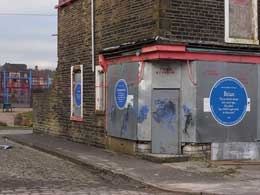
Kevin Carter, Peer Plaques, Burnley. Photo: Kevin Carter
As part of major regeneration schemes temporary works can be integrated to engage communities about the process of change.
Follow this link to see a case study of Kevin Carter's work in Burnley.
Public Realm Improvements
There is great potential for public art to contribute to the public realm, however the best locations will not necessarily correspond with potential development sites able to deliver the level of infrastructure required. This is particularly true in areas with little large-scale development activity or potential, but where there are aspirations to enhance the public realm in order to stimulate economic regeneration, reinforce town or local centre identity, or to establish more attractive destinations for visitors.
In this instance authorities should aim to better define and estimate the costs of the public art aspirations as part of a defined strategy, and develop these requirements as part of public funding initiatives or as the basis of standard charges applying to development sites that are not considered key with regards to integrated public art delivery (see Standard Charges and Infrastructure Levies).
Follow this link to view the funding section on Public Art Online.
Public Art for the Public Realm
Our streets and open spaces provide perhaps the most appropriate setting for public art. By integrating the work and creative thinking of artists into the design of our public realm, we can achieve the benefit of distinctive places that best interpret the use, history or hidden meaning of a space, and which better express the collective values and aspirations of the communities that use them. Public art can make us think about the places that we live, and help to foster a strong sense of ownership.
Our experience of public art is very different, however, from some of the more functional elements of pubic realm design, and the strong feelings it is often intended to produce can dissuade the investors and managers of public space from engaging artists to contribute to the design of public places. The fear of producing poor public art can be perceived as more important than the benefits of successful schemes, leading to a preference for ‘safer’ options. There are of course many examples of poor public spaces that do not include public art, and in many cases this has resulted from a lack of creativity, that looks to find a design solution that is appropriate for the unique place that it relates to.
A public art approach which looks to design for the specifics of a particular place is very much in keeping with the best examples of urban and landscape design, and the incorporation of an artist within the process of designing the public realm is in many ways the low risk approach to place making.
A Strategic Approach
Successful public art, as with other design aspects of the built environment, should not be left to chance and the setting aside of a sum of money to deliver a work of art somewhere along the way is not recommended. Within the public realm in particular, the preparation of agreed principles to guide the design is essential. As part of this, the establishment of a public art / public realm strategy will help to steer the different approaches to working with artists.
An integrated public realm strategy will determine broad guidelines and principles as well as setting out recommendations for the integration and procurement of public art for specific locations within the town.
A strategy recognises the physical contribution that a successfully integrated public art policy can bring by improving identity through the creation of new landmarks, focusing attention on distinctive views, or signalling the different character and function of individual spaces. Public art can also support both perceived and actual aspects of community safety through improved legibility and the presence of well designed, well maintained and appropriately sited work.
In addition, a strategy highlights other ‘non-physical’ properties that public art has to offer, and how they can be used to support an area’s wider strategies for economic, social and cultural development. For example by providing new imagery that will contribute to the broader identity of the town, or by supporting and enhancing the promotion of inward investment through new development.
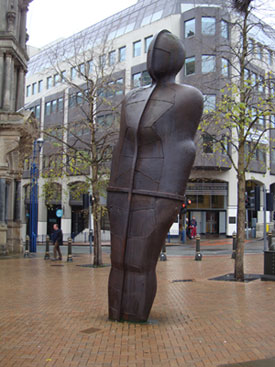
Iron:Man by Anthony Gormley, Victoria Square, Birmingham.
Photo Mark Luck
Iconic or landmark public art can be used to improve legibility, and signal the spirit of regeneration and renewal to a wider market
Scope and Potential
The recommendations and proposals within a strategy should recognise that the role of public art needs to relate to the specific context and use of an area.
Areas that attract visitors provide a focus for significant public funded commissions to enhance the experience and identity of the town. Public art integrated into these high profile areas needs to be at the heart of the public realm design process, and should be sophisticated in its breadth of visual references, responsive to tradition and yet contemporary in style and content. In addition there is a need for the work to be physically and conceptually robust, site specific and accessible.
Artists can also have a huge impact on the legibility of the public realm, and there are opportunities for public art to be used in harmony with other mechanisms at arrival points and along primary pedestrian routes. Integrated works of art can provide primary landmarks as aids to area identification where none currently exist, or help to focus attention on key physical qualities and other characteristics. Strategically located work can encourage exploration, bridge gaps in route connections and assist orientation, and can be used to highlight key buildings, places and resources both during the day and at night.
But it is also the process of making places that can be facilitated by artists who may be better placed to engage and enthuse communities raising the level of debate, involvement and ownership of the public realm.
Within primary business and retail areas there is a need to develop a creative and integrated approach to the design, refurbishment and management of commercial buildings. Regeneration initiatives should acknowledge the role of art and artists as innovators and major contributors to the future success of the town’s core and seek out their input at key stages of potential and real change.
Within residential areas the emphasis is on encouraging and expressing community pride. Working with residents and property owners, artists can help to interpret and improve local perceptions of an area, in order to generate and enhance a sense of place.
Establishing a Framework
Understanding the physical context of a place is key to establishing an effective public art/public realm strategy. Where are the priority public spaces within the town or city, how are they connected, which routes are most used and which routes would you want pedestrians to use? By mapping the main routes and spaces and further understanding patterns of activity and function a network or framework can be established that can inform priority locations for physical improvements and the integration of public art.
Key decisions need to be made about the potential of places and how they might be affected by investment. Is an existing place desirable, established, well used and attractive, and if so will investment reinforce these qualities and add further interest? At the other extreme is a place underused, vacant or even derelict, can investment be used to change perceptions, create a buzz, and bring activity and new uses? Can public art led improvements be used as a catalyst and what are the timescales for change? Are initial improvements vulnerable given a lack of activity, and is the work considered to be permanent or temporary?
It is important to recognise the overall function of a public space and how activities can vary from day to night or from season to season. How will the user of a space interact with the work? Public spaces vary and can be seen as movement corridors, arrival points, junctions, settings for key buildings, event spaces, commercial hubs, parks and gardens, viewing points or incidental spaces in which to meet, have a conversation or simply watch the world go by. The type of space may determine the approach, scale, materials and level of detail that public art should bring. For example a highway junction, which is passed through at speed, will need a different response to an intimate space where a person may be expected to spend time. Arts and lighting can be a useful way of determining the way in which a place reads at night, and can be used to emphasise the key architectural and historic landmarks of a place. However the determining factor must be aimed at night-time patterns of use so that there will be an audience for this type of intervention, and as such experience a vibrant evening.
In most cases a range of spaces and solutions will provide for a successful place making which is distinctive, attractive, legible and memorable.
Writing the Brief
When key priorities have been established it is useful to consider developing artist briefs for each specific site. The brief should not however determine the precise nature of the work or be too restrictive so as to stifle creativity.
The role of the artist's brief should be to outline the context for the design commission. It is useful to describe the site; what are considered to be its positive as well as its negative attributes. What is the wider context of the town or neighbourhood, and how does it function in terms of its use, traditions, materials, aspect, economy and social mix? Are there any existing development plans for the wider area? Are these being implemented, or are they more aspirational? How is the site to be maintained?
Broadly speaking, what are the expectations of the project? Should the work reinforce, reinterpret or reinvent the space and its existing patterns of use? Who is funding the project, and what are their expectations? Are there local stakeholders and what is their involvement in the project? What are the processes for approval? Is all of the funding in place, is planning permission required, and is there a commissioning panel?
Finally the brief should clearly establish the mechanisms for the commission and what is expected regarding any submission of ideas.
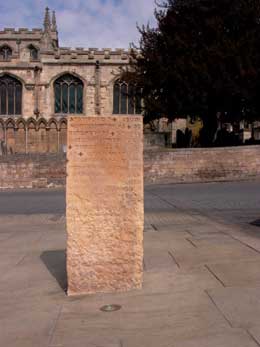
Wolfgang Buttress, Milestone, Market Square, Stamford.
Photo: Wolfgang Buttress
The incorporation of incidental elements can raise questions about the place and its past.
Guidelines for Procurement
The strategy should outline procedures for the promotion and procurement of art. There is a need to be proactive when identifying and prioritising sites and projects, and specialist advice can be drawn upon to develop the artist’s briefs and to facilitate the procurement processes.
To support the implementation of a public realm strategy the setting up of a Public Realm Forum can provide accountability and co-ordination of capital projects, arts commissions and ongoing public realm investment. Where there is little experience within local authority staff resources, these mechanisms can be facilitated by an independent public art project manager.
Standard Charges and Infrastructure Levies
Whist tariffs or standard charges have been adopted by a relatively small number of local authorities such as Swindon and Milton Keynes. Recent Government proposals related to a Community Infrastructure Levy (CIL) have increased debate around these issues.
The proposed CIL seeks to allow local authorities to establish a standard charging system or levy from all development schemes for the delivery of qualifying off-site infrastructure. The current proposal presumes that the existing system of Section 106 contributions will remain as an available mechanism to raise money for the delivery of planning requirements more directly linked to the specific development site.
CIL will be set by the charging authority (those local authorities responsible for drawing up development plan documents), as part of the local development framework, and it is these authorities that will choose whether or not to implement the CIL. If an authority decides to proceed with the CIL it will need to have developed its development plan, and in addition set out and established the cost of the infrastructure needed to deliver the plan.
The charging authority will then prepare a charging schedule that will be applied to all development on the basis of a predetermined unit of development, for example, per square foot typically for commercial developments or per dwelling when applied to residential development. The delivery of infrastructure could however be implemented by either the charging authority or another national, regional or joint body as appropriate.
Public art is not specifically highlighted within government guidance relating to the CIL. Infrastructure requirements typically focus on areas such as roads and other transport facilities, flood defences, schools, hospitals, sporting facilities, open spaces and affordable housing, however the emerging guidance does include for local authorities to determine local infrastructure priorities through the planning process.
In many ways the challenges of providing infrastructure echo those of establishing quality development that meets the design and environmental standards that are set and demanded by local communities. As such the role of artists in providing quality built environments, particularly within the public realm and public buildings, can be factors in determining the expectation, costs and delivery of public facilities.
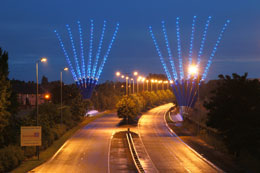
Peter Fink, Mersey Wave, Liverpool.
Photo: Peter Fink, art2architecture
Standard charging has the potential to fund public art aspirations away from priority development sites.
In the Governments March 2008 budget statement powers to allow local authorities to use CIL as a mechanism for raising funds for infrastructure where delayed until April 2010. The assumptions behind CIL remain, however, good practice with regard to planning ahead and more fully understanding the infrastructure needs of an area, and the role, use and opportunities for public art within infrastructure projects. In order to do this preparations for public buildings, highway or public realm improvements and flood and sea defences should give full consideration to the integration and appropriate costs related to public art, in order to ensure that the highest standards are achieved.
Public Infrastructure
Establishing budgets for planning obligations may ultimately be more straightforward for projects such as transport infrastructure, new schools, health centres and other community facilities, either through existing contributions or CIL arrangements. The role and contribution of public art within these types of projects, which are very much within the public realm, should not be overlooked. In establishing infrastructure costs for such projects the costs of delivering appropriate design standards, including public art, should be fully integrated into the delivery strategy.
If the role of artists as part of the quality design agenda can be firmly established then the integrated delivery of public art can be established alongside other aspects of the scheme. A good analogy can be drawn with sustainable design principles. For example if a new school is costed at a overall figure of say £3 million, it is presumed that this figure will deliver a low energy design solution, and a quality teaching space that is fit for purpose. The visual environment of the new school is also a key aspect, and the role of artists to create a stimulating environment within which to educate can also be strongly argued. As such the infrastructure costs associated with public art should not only be considered in terms of stand-alone projects or artworks, but as an integral part of the delivery of all major public infrastructure and community buildings. The ‘Percent for Art’ guide can be used as part of an outline costing exercise to determine overall target budgets.
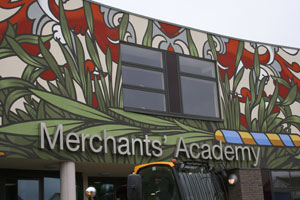
Façade wall painting by Tod Hanson, Merchants’ Academy, Bristol.
Photo Ginkgo Projects
Public building projects should aim to create environments that connect, inspire, educate and heal, and integrate public art which adds to the quality of life.
Conclusions
Public art has a key role within the broader quality design debate, which lies at the heart of delivering sustainable development solutions though the planning system. The successful delivery of integrated public art very much depends on a creative approach to forward planning, and project management practices, which are open to pursuing opportunities at each stage of the development process.
Designing for place is now a common goal of the planning system, and public art helps to deliver identity and distinctiveness, particularly when entered into in a spirit of enthusiasm and energy. In order to achieve this we need to be flexible, diverse and open to creative and collaborative working.
References and Further Reading
National Policies and Guidance
Department for Communities and Local Government
Circular 11/95 - Use of Conditions in Planning Permission
Circular 01/06 – Guidance on Changes to the Development Control System
Planning Policy Statement 1: Delivering Sustainable Development – 2005
Planning Policy Statement 11: Regional Spatial Strategies – 2004
Planning Policy Statement 12: Local Development Frameworks – 2004
The Community Infrastructure Levy – August 2008
CABE
By Design: Urban Design in the Planning System, Towards Better Practice – 2000
Protecting Design Quality in Planning – 2003
Creating Excellent Buildings: A Guide for Clients – 2003
Creating Successful Masterplans: A Guide for Clients - 2004
The Use of Urban Design Codes - 2004
Design and Access Statements: How to Write, Read and Use Them - 2007
IXIA – Public Art Think Tank
Public Art and the Planning System and Process in England – June 2007
Copyright - Mark Luck and PASW 2008
